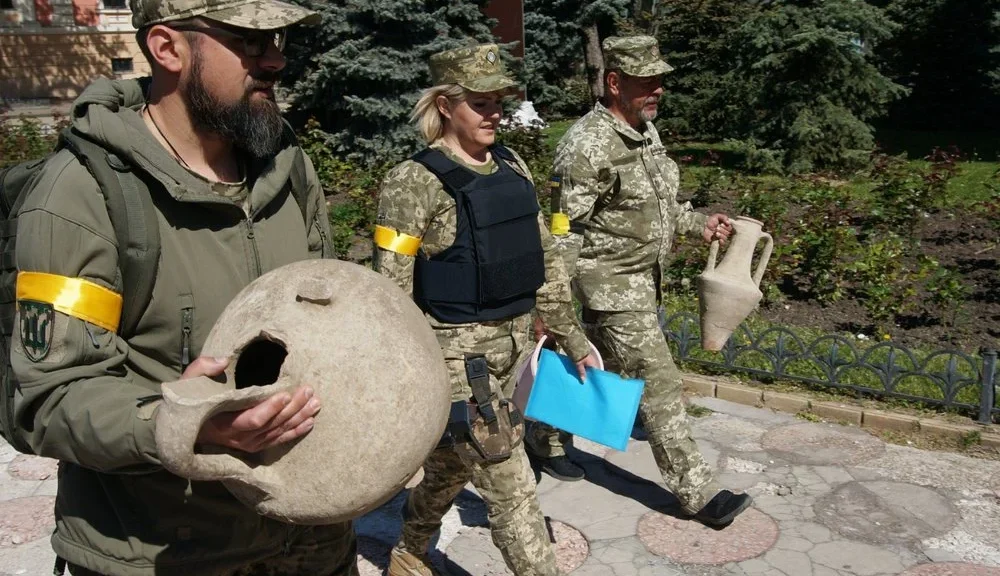Ukrainian Soldiers Discover Archaeological Treasures While Digging Defenses in Port City Odessa
Trench warfare is a way of life in Ukraine: In an unsettling echo of past wars, the hand-dug ditches provide defensive cover for troops as Russia’s invasion stretches on.

Now, reports the Kyiv Independent, a Ukrainian defence unit discovered something unexpected while digging a trench in Odessa: ancient amphorae.
Soldiers with the Ukrainian 126th Territorial Defense found the tall, bottle-necked jars along with some ceramic shards earlier this month, taking to Facebook to document the find.
According to the defense troops, the amphorae have been dated to the fourth or fifth centuries C.E., a time when Odessa was a Roman settlement called Odessus.
The third-most populous city in Ukraine and an important shipping hub on the southwestern coast, Odessa is currently under Russian siege. The Times’ Tom Ball reports Russia has been targeting the city with missile strikes and a naval blockade to choke the port’s exports of Ukrainian grain and wheat.
The amphorae, which are in excellent condition, have been transferred to the Odessa Archaeological Museum.
“We are not Russians, we preserve our history,” journalist Yana Suporovska tells Heritage Daily.
Amphorae were first used in the Bronze Age more than 3,000 years ago and became the dominant means of storing and transporting goods in civilizations across the Mediterranean.
The urns had different shapes depending on what was they were designed to hold. Tall and slim ones were used for wine; broader ones transported dried fish and cereals; miniature ones stored perfume; and a special souvenir amphora would be filled with olives and given to the winners of the Panathenaic Games—the ancient ancestor of the modern Olympics.

Used by the Egyptians, Greeks, Romans, and Byzantines, amphorae were storage solutions that could double as works of art. Decorative Greek vessels, for example, depicted moments from Greek mythology, the triumphs of great athletes, and even erotic scenes.
Given their ubiquity in the ancient world, amphorae still turn up today. Researchers found 6,000 of them in a Roman shipwreck off the Greek island of Kefallinia in 2019. And Russian President Vladimir Putin thought he had discovered two of the ancient urns during a scuba-diving expedition in the Black Sea in 2011, according to the Guardian’s David Batty. Putin’s chief spokesperson, Dmitry Peskov, later fessed up and admitted archaeologists had planted the jars for Putin to find.
Russian forces have not shown the same interest in preserving cultural heritage in Ukraine. Earlier this month, Artnet’s Taylor Dafoe reports, Ukrainian president Volodymyr Zelensky accused Russia of destroying nearly 200 cultural heritage sites in its ongoing invasion.
Unesco’s figures differ slightly; as of May 16, the agency had verified damage to 133 cultural sites, including museums, religious sites, libraries, monuments and more. Shortly after the invasion began, Unesco Director-General Audrey Azoulay said in a statement that cultural heritage “must be safeguarded as a testimony of the past, but also as a catalyst for peace and cohesion for the future, which the international community has a duty to protect and preserve.”
Among the destroyed sites, the Jerusalem Post reports were ancient Scythian tombs that were over 1,000 years old. Ukraine’s Foreign Affairs Ministry accused Russian forces of specifically targeting the cultural site.
Though war helped uncover the trench amphorae, it presents a very real threat to Ukraine’s cultural treasures—even the ones that have yet to be discovered. In a sign of the times, Heritage Daily reports, the ongoing conflict has made it impossible for archaeologists to document the site where the amphorae were found.
